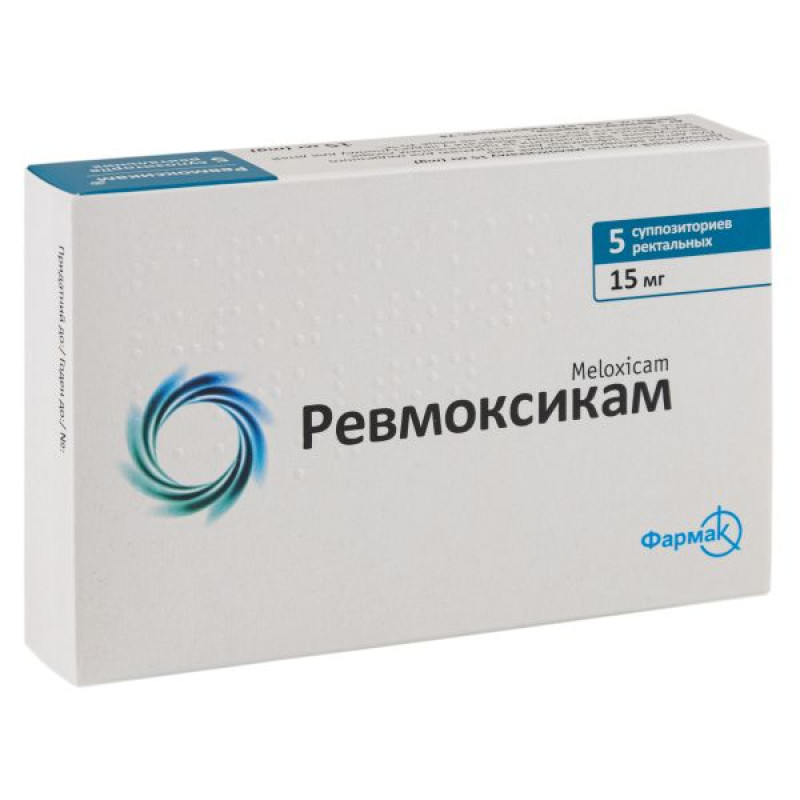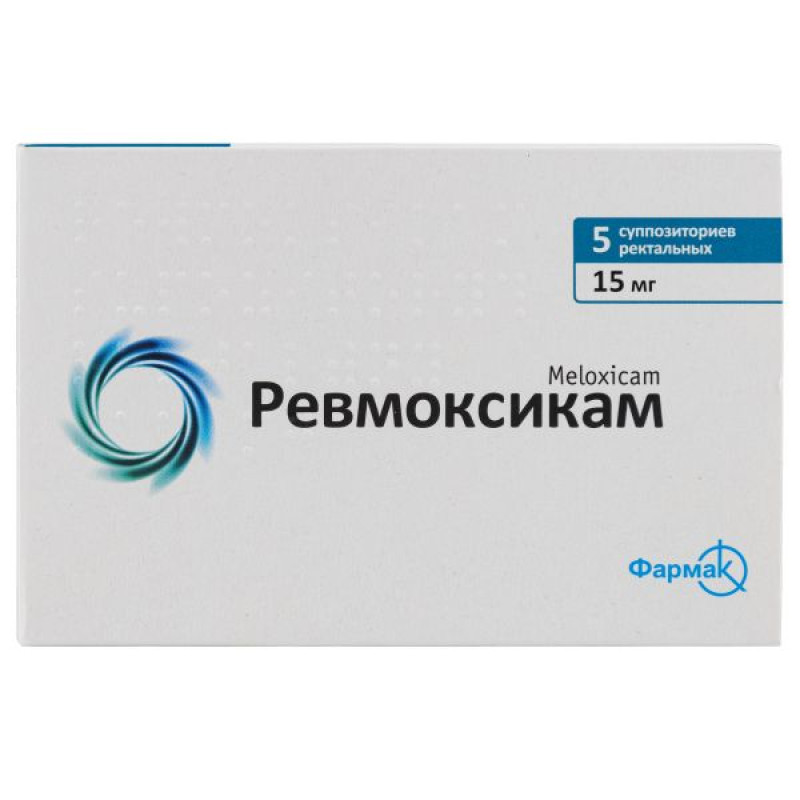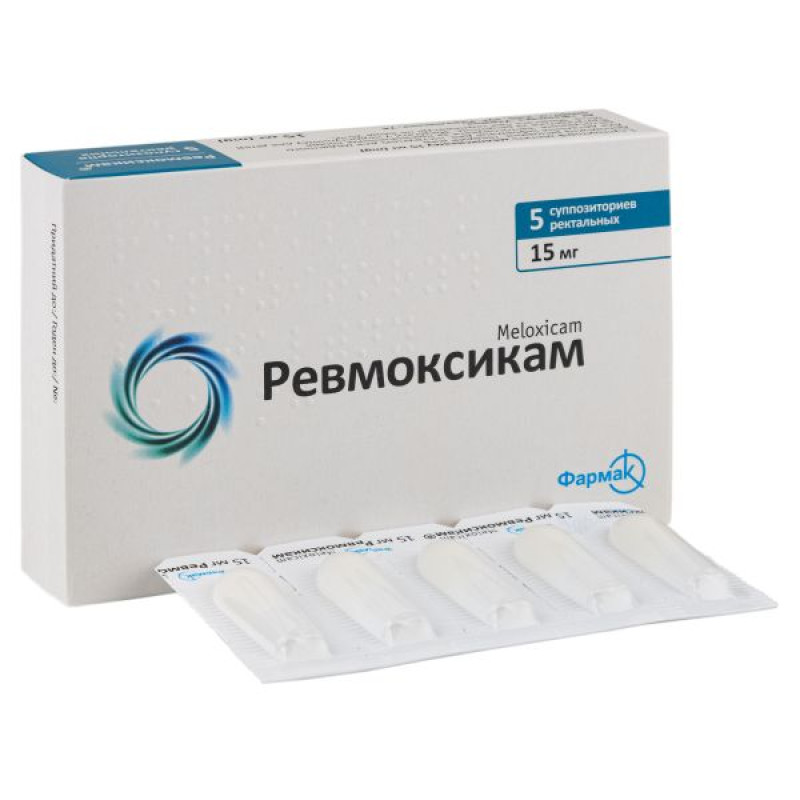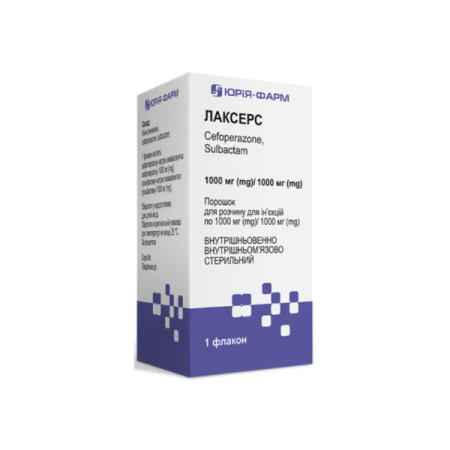Revmoxicam rectal suppositories 15 mg blister No. 5

Instructions for use Revmoxicam rectal suppositories 15 mg blister No. 5
Composition
active ingredient: meloxicam;
1 suppository contains meloxicam 15 mg;
excipient: solid fat.
Dosage form
Rectal suppositories.
Main physicochemical properties: suppositories of light yellow color with a greenish tint, cigar-shaped. The presence of a coating on the surface of the suppository is allowed.
Pharmacotherapeutic group
Nonsteroidal anti-inflammatory and antirheumatic drugs. Meloxicam. ATX code M01A C06.
Pharmacological properties
Pharmacodynamics
Anti-inflammatory, analgesic, antipyretic. The mechanism of action is mainly due to selective inhibition of cyclooxygenase-2, which leads to inhibition of the biosynthesis of pro-inflammatory prostaglandins in the focus of inflammation. Due to its low affinity for cyclooxygenase-1, the drug in therapeutic doses does not have a negative effect on the biosynthesis of cytoprotective prostaglandins in the gastrointestinal tract and kidneys, and does not inhibit the functional activity of platelets. It is a chondroneutral drug, does not affect the synthesis of proteoglycan by chondrocytes of articular cartilage.
Pharmacokinetics
When administered rectally, meloxicam is well absorbed into the systemic circulation, with a bioavailability of 89%. Steady-state therapeutic blood concentrations are achieved 3-5 days after initiation of treatment. Plasma protein binding is over 99%. It is biotransformed in the liver, mainly by oxidation to form four inactive metabolites. The main role in meloxicam metabolism is played by the enzymes CYP2CP and CYP3A4, as well as peroxidase. The volume of distribution of the drug is low - an average of 11 l, plasma clearance - 8 ml/min. The half-life is approximately 20 hours, which allows the drug to be taken once a day. Excretion from the body occurs by the kidneys and intestines in equal proportions; 5% of the daily dose is excreted unchanged by the intestines. The drug passes through histohematological barriers and penetrates well into the synovial fluid, where its concentration is 50% of the level in blood plasma.
In the elderly, only a slight increase in the half-life of the drug is observed, as well as a decrease in plasma clearance (especially in women).
No significant changes in the pharmacokinetics of meloxicam and no increase in the risk of side effects were observed when the drug was used in patients with hepatic or moderate renal insufficiency (creatinine clearance - 20-40 ml/min).
Indication
Long-term symptomatic treatment of rheumatoid arthritis and ankylosing spondylitis. Short-term symptomatic treatment of exacerbation of osteoarthritis in case of insufficient clinical effect of meloxicam at a dose of 7.5 mg/day.
Contraindication
- Hypersensitivity to meloxicam or to other components of the drug, or to active substances with a similar effect, such as non-steroidal anti-inflammatory drugs (NSAIDs), aspirin;
- meloxicam should not be prescribed to patients who have symptoms of asthma, nasal polyps, angioedema or urticaria associated with the use of acetylsalicylic acid or other NSAIDs, as cross-hypersensitivity reactions are possible;
- history of gastrointestinal bleeding or perforation associated with previous NSAID therapy;
- history of active or recurrent peptic ulcer/bleeding (two or more separate confirmed episodes of ulceration or bleeding);
- history of proctitis and rectal bleeding;
- severe liver failure;
- severe renal failure without dialysis;
- gastrointestinal bleeding, history of cerebrovascular bleeding or other coagulopathies;
- other hemostatic disorders or concomitant therapy with anticoagulants;
- severe heart failure;
- III trimester of pregnancy;
- children and adolescents under 16 years of age.
Interaction with other medicinal products and other types of interactions
Other nonsteroidal anti-inflammatory drugs (NSAIDs) and acetylsalicylic acid > 3 g/day.
Concomitant administration of prostaglandin synthetase inhibitors due to synergistic effects may lead to an increased risk of bleeding and ulceration in the digestive tract, therefore such combination treatment is not recommended. Combination with other NSAIDs, including acetylsalicylic acid, prescribed in anti-inflammatory doses (≥ 1 g for a single dose or ≥ 3 g for a daily dose) is not recommended.
Corticosteroids (e.g., glucocorticoids).
Concomitant use of corticosteroids requires caution due to the increased risk of gastrointestinal bleeding or ulceration.
Oral anticoagulants, antiplatelet agents, systemic heparin, thrombolytic agents, and selective serotonin reuptake inhibitors: increased risk of bleeding due to inhibition of platelet function. If such combined treatment is necessary, close monitoring is recommended.
The concomitant use of NSAIDs and anticoagulants or heparin is not recommended in geriatric practice or at therapeutic doses. Otherwise, caution is required when using heparin due to the increased risk of bleeding. Close monitoring of the INR (international normalized ratio) is necessary if the combination is proven to be unavoidable.
Diuretics, ACE inhibitors and angiotensin II antagonists.
NSAIDs may reduce the effect of diuretics and other antihypertensive drugs. Angiotensin II receptor antagonists, ACE inhibitors have a synergistic effect with cyclooxygenase inhibitors in reducing glomerular filtration. In patients with pre-existing renal impairment (e.g. dehydrated patients or elderly patients with impaired renal function), this may lead to acute renal failure, which is usually reversible. Therefore, this combination should be used with caution, especially in elderly patients. Patients should be adequately hydrated and renal function should be monitored after initiation of concomitant therapy and periodically thereafter.
Other antihypertensive drugs (e.g. beta-blockers).
NSAIDs reduce the antihypertensive effect, which is associated with an inhibitory effect on vasodilator prostaglandins.
Calcineurin inhibitors (e.g., cyclosporine, tacrolimus).
The nephrotoxicity of calcineurin inhibitors may be potentiated by NSAIDs due to side effects mediated by prostaglandin inhibition. Renal function should be assessed during combination therapy. Close monitoring of renal function is recommended, especially in the elderly.
Contraception: NSAIDs have been reported to reduce the effectiveness of intrauterine devices, but the data require further confirmation.
Lithium. There are data on NSAIDs increasing the level of lithium concentration in the blood plasma. The simultaneous use of lithium and NSAIDs is not recommended. It is necessary to monitor the content of lithium in the blood plasma at the beginning of treatment, when adjusting the dose and when stopping treatment with meloxicam.
Methotrexate. NSAIDs may reduce the tubular secretion of methotrexate, thereby increasing its plasma concentration. Therefore, concomitant use of NSAIDs is not recommended in patients receiving high doses of methotrexate (more than 15 mg/week). The risk of interaction between NSAIDs and methotrexate should also be considered in patients receiving low doses of methotrexate, particularly in patients with impaired renal function. If combined treatment is necessary, blood count and renal function should be monitored. Caution should be exercised when NSAIDs and methotrexate are administered for 3 consecutive days, as plasma levels of methotrexate may increase and toxicity may increase. Although the pharmacokinetics of methotrexate (15 mg/week) are not affected by concomitant treatment with meloxicam, it should be taken into account that the hematological toxicity of methotrexate may increase during treatment with NSAIDs.
Cholestyramine binds meloxicam in the digestive tract, leading to its more rapid excretion.
Meloxicam is almost completely destroyed by hepatic metabolism, approximately two-thirds of which occurs via cytochrome (CYP) P450 binding and one-third via peroxidase oxidation.
Pharmacokinetic interactions between meloxicam and other drugs at the metabolic stage are possible due to their effects on CYP 2C9 and/or CYP 3A4.
No interactions of meloxicam with antacids, cimetidine, digoxin and furosemide have been identified when taken simultaneously.
Drug interactions with oral antidiabetic agents cannot be ruled out.
Application features
Adverse reactions can be minimized by using the lowest effective dose for the shortest duration necessary to control symptoms.
The recommended maximum daily dose should not be exceeded in case of insufficient therapeutic effect, nor should additional NSAIDs be used, as this may increase toxicity while the therapeutic benefit has not been proven. The concomitant use of meloxicam with NSAIDs, including selective cyclooxygenase-2 inhibitors, should be avoided.
Meloxicam is not suitable for the treatment of patients requiring relief of acute pain.
If there is no improvement after several days, the clinical benefit of treatment should be reassessed.
Attention should be paid to a history of esophagitis, gastritis and/or peptic ulcer in order to ensure that they are completely treated before starting therapy with meloxicam. The possibility of relapse should be taken into account in patients who have used meloxicam and in patients with a history of such cases.
Gastrointestinal disorders.
As with other NSAIDs, patients with gastrointestinal diseases and those taking anticoagulants should be carefully monitored when using the drug. Meloxicam should not be prescribed in the presence of peptic ulcer or gastrointestinal bleeding.
The risk of gastric bleeding, ulceration or perforation is higher with increasing NSAID doses in patients with a history of ulceration, particularly if complicated by bleeding or perforation, and in the elderly. These patients should start treatment with the lowest available dose. Combination therapy with protective drugs (misoprostol or proton pump inhibitors) should be considered in such patients, as well as in patients who require concomitant use of low-dose acetylsalicylic acid or other drugs that may increase the risk of gastrointestinal complications, and in patients who require concomitant use of low-dose acetylsalicylic acid or other drugs that increase the risk of gastrointestinal complications.
Patients with a history of gastrointestinal toxicity, especially elderly patients, should be informed of any unusual abdominal symptoms (especially gastrointestinal bleeding), especially during the initial stages of treatment.
Caution should be exercised when using concomitant medications that may increase the risk of ulceration or bleeding, in particular heparin as radical therapy or in geriatric practice, anticoagulants such as warfarin, or other NSAIDs, including acetylsalicylic acid at anti-inflammatory doses (≥ 1 g - single dose or ≥ 3 g - total daily dose) (see section "Interaction with other medicinal products and other forms of interaction").
If gastrointestinal bleeding or ulceration occurs in patients taking meloxicam, treatment should be discontinued.
NSAIDs should be used with caution in patients with a history of gastrointestinal diseases (ulcerative colitis, Crohn's disease), as these conditions may be exacerbated (see section "Adverse reactions").
Cardiovascular disorders.
Close observation is recommended in patients with hypertension and/or a history of mild to moderate congestive heart failure, as fluid retention and edema have been reported with NSAID therapy.
In patients with risk factors, clinical monitoring of blood pressure is recommended at the beginning of therapy, especially at the beginning of treatment with meloxicam.
Patients with uncontrolled hypertension, congestive heart failure, established ischemic heart disease, peripheral arterial disease and/or cerebrovascular disease should be treated with meloxicam only after careful consideration. Similar consideration is necessary before initiating long-term treatment in patients with risk factors for cardiovascular disease such as hypertension, hyperlipidemia, diabetes mellitus, smoking.
NSAIDs may increase the risk of serious cardiovascular thrombotic events, myocardial infarction and stroke, which can be fatal. This risk may increase with increasing duration of treatment. This risk may be greater in patients with cardiovascular disease or risk factors for such disease.
Skin disorders.
Serious skin reactions, some of which were fatal, including exfoliative dermatitis, Stevens-Johnson syndrome and toxic epidermal necrolysis, have been reported very rarely with the use of NSAIDs. The highest risk of these reactions was observed at the beginning of treatment, with the majority of these reactions occurring within the first month of treatment. Meloxicam should be discontinued at the first appearance of skin rash, mucosal lesions or other signs of hypersensitivity.
Due to the possibility of side effects on the skin and mucous membranes, special attention should be paid to the appearance of such symptoms. If side effects occur, treatment with meloxicam should be discontinued.
Cases of fixed drug eruption have been reported with meloxicam. Meloxicam should not be re-administered to patients who have had a history of fixed drug eruption associated with meloxicam.
Potential cross-reactivity may occur with other oxicams.
Anaphylactic reactions.
As with other NSAIDs, anaphylactic reactions may occur in patients with no known reaction to meloxicam. Meloxicam should not be used in patients with the aspirin triad. This symptom complex occurs in patients with asthma who have reported rhinitis with or without nasal polyps or who have experienced severe, potentially fatal bronchospasm after taking acetylsalicylic acid or other NSAIDs. Emergency care should be sought if an anaphylactoid reaction occurs.
Kidney function.
The greatest risk of such a reaction is observed in elderly patients, in patients with dehydration, with congestive heart failure, in patients with cirrhosis of the liver, with nephrotic syndrome and chronic renal impairment, as well as in patients receiving concomitant therapy with diuretics, ACE inhibitors or angiotensin II receptor blockers, or after volume-depleting surgical interventions, patients with lupus nephropathy, severe liver dysfunction (serum albumin ˂ 25 g/l or ≥ 10 according to the Child-Pugh classification). Such patients require control of diuresis and monitoring of renal function at the beginning of therapy.
In rare cases, NSAIDs can lead to interstitial nephritis, glomerulonephritis, renal medullary necrosis, or the development of nephrotic syndrome.
The dose of meloxicam for patients with end-stage renal disease on dialysis should not exceed 7.5 mg (in tablet form). For patients with mild to moderate renal impairment, the dose may not be reduced (creatinine clearance <100 mL/min).
> 25 ml/min).
Liver disorders.
As with most NSAIDs, isolated cases of increased transaminases or other liver function tests have been described. In most cases, these abnormalities were minor and transient. In case of persistent and significant abnormalities in liver function tests, meloxicam should be discontinued and control tests should be performed. In patients with clinically stable cirrhosis of the liver, the dose of meloxicam should not be reduced. Debilitated patients require more careful monitoring. As with other NSAIDs, caution should be exercised in elderly patients, who are more likely to have decreased renal, hepatic and cardiac function.
Sodium, potassium and water retention.
NSAIDs may increase sodium, potassium and water retention and may interfere with the natriuretic effect of diuretics, which may cause or exacerbate cardiac disorders or hypertension. Clinical monitoring is recommended in such patients.
In addition, the effect of antihypertensive drugs may be reduced. As a result, edema, heart failure, or hypertension may occur in susceptible patients. Therefore, clinical monitoring of patients at risk is necessary.
Other warnings and precautions.
Adverse reactions are often worse tolerated by elderly, frail, or debilitated patients who require close supervision.
Meloxicam, like any other NSAID, may mask the symptoms of infectious diseases.
Masking inflammation and fever.
The pharmacological action of meloxicam to reduce fever and inflammation may complicate the diagnosis of suspected non-infectious pain conditions.
The use of meloxicam, as with other drugs that inhibit cyclooxygenase/prostaglandin synthesis, may impair reproductive function and is therefore not recommended in women attempting to conceive. For women planning to conceive or undergoing investigation of infertility, discontinuation of meloxicam should be considered.
Use during pregnancy or breastfeeding
Revmoxicam® is contraindicated during the third trimester of pregnancy (see section “Contraindications”).
Inhibition of prostaglandin synthesis may adversely affect pregnancy and/or embryo-foetal development. Epidemiological data suggest an increased risk of miscarriage and of cardiac malformations and gastroschisis following the use of prostaglandin synthesis inhibitors in early pregnancy. This risk is believed to increase with increasing dose and duration of treatment.
From the 20th week of pregnancy, meloxicam may cause oligohydramnios due to fetal renal dysfunction. This may occur shortly after initiation of treatment and is usually reversible after discontinuation of treatment. In addition, there are reports of narrowing of the ductus arteriosus after treatment in the second trimester of pregnancy, most of which resolved after discontinuation of treatment. Therefore, during the first and second trimesters of pregnancy, meloxicam should be prescribed only when absolutely necessary. If meloxicam is used by a woman planning a pregnancy or who is pregnant during the first and second trimesters of pregnancy, the dose should be kept as low as possible and the duration of treatment should be as short as possible. Antenatal monitoring for oligohydramnios and narrowing of the ductus arteriosus should be considered after exposure to meloxicam for several days, starting from the 20th week of gestation. The use of Revmoxicam® should be discontinued if oligohydramnios or narrowing of the ductus arteriosus is detected.
During the third trimester of pregnancy, all prostaglandin synthesis inhibitors may pose a risk to the fetus:
– cardiopulmonary toxicity (premature narrowing/closure of the ductus arteriosus and pulmonary hypertension);
- kidney dysfunction, which may develop into renal failure with oligohydramnios (see above).
Possible risks in the last stages of pregnancy for the mother and newborn:
– possible prolongation of bleeding time, anti-aggregation effect even at very low doses;
Although there are no specific data for meloxicam, NSAIDs are known to pass into breast milk, so meloxicam is contraindicated in breastfeeding women.
Ability to influence reaction speed when driving vehicles or other mechanisms
There is no data on the effect of the drug on the ability to drive a car or operate other mechanisms. However, if side effects such as visual impairment, dizziness, drowsiness or other central nervous system disorders develop, it is recommended to refrain from driving a car or operating mechanisms.
Method of administration and doses
Apply to adults and children over 16 years of age:
Exacerbation of osteoarthritis (in case of insufficient clinical effect of meloxicam at a dose of 7.5 mg/day): 15 mg/day (1 suppository).
Rheumatoid arthritis: 15 mg/day (1 suppository).
Ankylosing spondylitis: 15 mg/day (1 suppository).
The maximum recommended daily dose of meloxicam for adults is 15 mg.
Since the risk of adverse reactions increases with increasing dose and duration of treatment, the lowest effective daily dose should be used for the shortest possible treatment period.
When combined administration of different forms of meloxicam (capsules, tablets, suppositories, solution), the total daily dose should not exceed 15 mg.
Children
The drug is used to treat children over 16 years of age.
Overdose
Symptoms of acute overdose: lethargy, drowsiness, nausea, vomiting, epigastric pain, possible gastrointestinal bleeding. Severe poisoning can lead to arterial hypertension, acute renal failure, liver dysfunction, coma, cardiac arrest. Possible phenomena described in the section "Adverse reactions".
Treatment: drug withdrawal, rectal lavage, symptomatic therapy. There is no specific antidote. In a clinical trial, accelerated elimination of meloxicam was demonstrated against the background of oral administration of cholestyramine 4 g 3 times a day.
Adverse reactions
Some side effects possible with the use of meloxicam have been recorded.
Research and epidemiological data suggest that the use of some NSAIDs (especially at high doses and with long-term treatment) may be associated with a small increased risk of vascular thrombotic events (e.g. myocardial infarction or stroke).
Edema, hypertension, and heart failure have been observed with NSAID treatment.
Most of the observed side effects are of gastrointestinal origin. Peptic ulcer, perforation or gastrointestinal bleeding, sometimes fatal, may occur, especially in elderly patients (see section "Special instructions"). Nausea, vomiting, diarrhea, flatulence, constipation, dyspepsia, abdominal pain, melena, haematemesis, ulcerative stomatitis, exacerbation of colitis and Crohn's disease, gastritis were observed less frequently after use.
Blood and lymphatic system disorders: Abnormal blood counts (including differential white blood cell count), leukopenia, thrombocytopenia, anemia. Very rare cases of agranulocytosis have been reported.
Concomitant administration of a potentially myelotoxic drug, especially methotrexate, may lead to cytopenia.
Immune system disorders: anaphylactic reaction, anaphylactoid reaction and other immediate-type allergic reactions, including shock.
Mental: confusion, disorientation, mood swings, night terrors, insomnia.
From the nervous system: dizziness, drowsiness, headache.
On the part of the organs of vision: visual function disorders, including blurred vision, conjunctivitis.
From the side of the organs of hearing and vestibular apparatus: vertigo, tinnitus.
Cardiac: palpitations.
Heart failure has been reported in association with NSAID treatment.
Vascular: increased blood pressure, hyperemia, hot flashes.
On the part of the respiratory system, chest organs and mediastinum: bronchial asthma in patients with allergies to acetylsalicylic acid and other NSAIDs, upper respiratory tract infections, cough.
On the part of the digestive tract: gastrointestinal perforation, occult or macroscopic gastrointestinal bleeding, gastroduodenal ulcer, colitis, gastritis, esophagitis, stomatitis, abdominal pain, dyspepsia, diarrhea, nausea, vomiting, constipation, flatulence, belching.
Gastrointestinal bleeding, ulceration, or perforation can be potentially fatal.
From the hepatobiliary system: hepatitis, impaired biochemical indicators of liver function (for example, increased levels of transaminases or bilirubin), jaundice, liver failure.
On the part of the urinary system: sodium and water retention, hyperkalemia, acute renal failure, changes in kidney function (increased creatinine and/or serum urea), urinary tract infections, urinary frequency disorders.
The use of NSAIDs may be accompanied by urinary disorders, including acute urinary retention.
General disorders and administration site conditions: edema, including edema of the lower extremities, burning, itching in the anorectal area.
Adverse reactions that have not been observed during use of the drug, but which are generally considered to be characteristic of other compounds of the class.
Organic renal damage is likely to lead to acute renal failure: very rare cases of interstitial nephritis, acute tubular necrosis, nephrotic syndrome and papillary necrosis have been reported (see section "Special warnings and precautions for use").
Reporting of suspected adverse reactions
Reporting adverse reactions after the registration of a medicinal product is important. This allows monitoring of the benefit/risk ratio when using this medicinal product. Medical and pharmaceutical professionals, as well as patients or their legal representatives, should report all cases of suspected adverse reactions and lack of efficacy of the medicinal product via the Automated Information System for Pharmacovigilance at the link: https://aisf.dec.gov.ua.
Expiration date
2 years.
Do not use the drug after the expiration date indicated on the package.
Storage conditions
Store at a temperature not exceeding 25 °C.
Keep out of reach of children.
Packaging
5 suppositories in a blister. 1 blister in a pack.
Vacation category
According to the recipe.
Producer
JSC "Farmak".
Location of the manufacturer and its business address
Ukraine, 04080, Kyiv, Kyrylivska St., 74.
Applicant
JSC "Farmak".
Location of the applicant and its business address
Ukraine, 04080, Kyiv, Kyrylivska St., 63.
There are no reviews for this product.
There are no reviews for this product, be the first to leave your review.
No questions about this product, be the first and ask your question.














